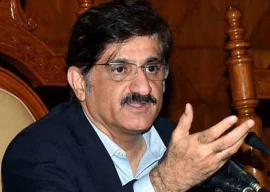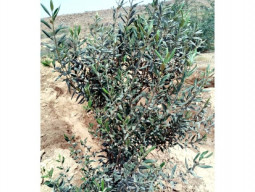
From April 15 to May 12, bhajans, maha aartis and rath yatras were organised and by May 1, the day the temple actually completed 200 years, 840,000 Jains had been fed, reported DNA. A stamp commemorating this celebration was released by Milind Deora, the minister of state for communications and IT, representing the Government of India, on April 17.
People in Pakistan will be surprised to know that there are at least a dozen major Indian Jain temples, all of them named Godiji Parshwanath, that trace their heritage to Pakistan’s Gori temple.
The Jain temples of Tharparkar are among Pakistan’s major archaeological monuments. The most impressive of them all, Gori Temple, is located in the village of Gori between Islamkot and Nagarparkar in Tharparkar district. This partly ruined temple is mysterious to most Pakistanis, since it has been abandoned for a long time. There are no Jains in Tharparkar today to the best of my knowledge.
The Jains in India are equally unaware of the original Gori Temple, although many have heard the legends about it. Authors in the past have yearned to find out about the current status of this long lost place of worship.
Part of the disconnect is caused by a linguistic hiccup because the name of the temple involves a retroflex r, which is generally rendered as Gori in Urdu but as Godi in Gujarati and Hindi.
Many of the Godiji Parshwanath temples in India are stunning marble structures with a history spanning one or two centuries, but none have a history as long as the original and the legendary Tharparkar temple. The Mumbai temple was established in 1812 as a building made of teak wood, housing an image brought from Sirohi (Rajasthan) thought to have been originally brought from Gori in Tharparkar. About 40 years ago, an ornate three-storey marble building was constructed at a cost of 80 million rupees. The temple has 10 shikhars or central towers and three more are currently being added.
The Mumbai celebrations have been organised on an unprecedented scale. Invitations accompanied by a box of sweets have been sent to 135,000 local families. Feasts prepared according to strict Jain rules served 800,000 individuals. Ingredients included 30,000 kilogrammes of flour and 2,000 kg of chili powder. Additionally, 1,500 tons of mango juice was acquired from different orchards and 20,000 workers have been hired for cleaning.
About 280 Jain monks and nuns attended the functions. Religious activities are guided by the Jain Acharya Padmasagar Suri. Among the festivities, four books that catalogue several thousand ancient Jain manuscripts have been released. Indeed, Jain institutions preserve some of the oldest collections of manuscripts in India.
The Jains are known for their financial acumen. They used to be recruited by Rajput rulers for financial management. The sultans of Delhi and Mughal rulers also relied on them. And today, Ajit Jain may succeed Warren Buffet in the US, and Anshu Jain may head the global Deutsche Bank in Europe.
The Gori temple in Tharparkar was dedicated to Lord Parshwanath, the 23rd Jain prophet who preached in the 8th century BC. Several Jain texts give an account of the history of the temple and legends surrounding it. The text “Shri Gaudi Parshvanath Stavan” by Nemavijaya was written in Tharparkar region itself. It mentions that the legendary image was brought to Bhodesar by a wealthy merchant called Megha Sa, in 1375 AD from Patan, a famous city in North Gujarat. The image was originally installed in 1171 AD, however it was buried and later found by someone in Patan. Megha Sa purchased it for 500 coins and brought it to his hometown. An angel appeared to him in a dream and instructed him to build a temple at a specific site in the desert where freshwater and rocks needed for construction would be found. Megha Sa built a temple and established a village named Gori near it. The account narrates several dramatic events in his life and mentions that the shikhar or central tower was finished by his son Mahio.
The temple is built in the classical Jain style. Like the famous Vimal Vasahi temple of 1021 AD at Mount Abu and the 1848 Hutheesing temple at Ahmedabad, it has one main temple surrounded by 52 smaller shrines, each housing one or more images of Jain prophets. It has 52 domes just like Vimal Vasahi. Unlike Vimal Vasahi, however, the interior of Gori temple was adorned with paintings.
Gori temple became a famous pilgrimage centre. An inscription of 1715 mentions some repairs as well. An Englishman named Stanley Napier Raikes visited the area in 1854. He writes that the main image was moved by the local ruler Soda Sutojee to a fort in 1716. It was kept buried and used to be taken out after a few years with great festivities that lasted a few days, and reburied in a secret location again. In 1832, the local ruler died in captivity without revealing where the image was buried.
When Jain Muni Vidyavijayaji visited Sindh in 1937, he noted that the temple was empty, but was guarded by a local Bheel. The temple was damaged because of a battle between the local chief and the British forces at one time, and an earthquake.
Because of the changes in the coastline and trade routes, the Jain population had already declined when Raikes had visited. About 400 or so Jains still in the area, left in 1947 when Partition took place. But the memory of the temple survives.
Many temples today are named Godiji Parshwanath in the memory of the original. Many of them are believed to have an image brought from the Gori temple. A majority of them are in the adjacent Rajasthan and Gujarat, but some are as far away as Hyderabad in South India. The original temple is now a legend and an enigma to the Jains.
Many Kutchi Jains, who now have a presence in not only Mumbai, but in other countries as well, have a historic connection with Tharparkar region. Some Jain clans even trace their descent from Megha Sa, the builder of the Gori temple.
Even setting aside legends and tradition, there is still something that makes the Gori temple unique – the paintings within the ranga-mandap dome. These paintings are older than any other frescos in the Jain temples of North India, with the exception of Ellora. In India, the temples have been renovated and any old frescos have been painted over. Gori paintings are also older than any other surviving frescos in Pakistan, with the possible exception of some Gandhara fragments.
The writer is a professor of computer science at Colorado State University and can be reached at malaiya@cs.colostate.edu
Published in The Express Tribune, May 18th, 2012.
COMMENTS (11)
Comments are moderated and generally will be posted if they are on-topic and not abusive.
For more information, please see our Comments FAQ
1719315628-0/BeFunky-collage-(8)1719315628-0-405x300.webp)


1731329418-0/BeFunky-collage-(39)1731329418-0-165x106.webp)













Excellent article,well researched with supported facts. You have an uncanny ability in researching, presenting the historical information and help connecting the dots.
Thanks!...Wonderful article....its really very important to aware the ancient Jain temple history. Pls share more if anyone knows another jain temp.
Yaswant is a great scholar on Jainism and active and dedicated Jain. Thanks for such a good information and historical details.
Wonderful. Please who ever has more information put it up. let us collect whatever we can. Even from other places like Thailand, Combodia, Maxico etc. Whereever there are ancient monuments we must collect pictures and the history.
Hi,
Thanks for sharing this wonderful article. Though we are very much aware of the history of the temple and also the same is mentioned in the official site, I would still like to have more pics if you have or more facts around it specially the archaeological facts........The idol here has been like looked upto with lot of reverence and respect so I m sure it would had its presence felt wherever it was. More information would help us strengthen the belief.
Also if the temple structure still is in hands of Jains in Pakistan? if there is any renovation/restoration etc that needs to be done?
Regards
I would like to have more details of the site of pakistan and the history of this temple there, can any one assist me for the same. the events of 200 years celebrations are at https://www.facebook.com/GodijiParshwanath
G7
@Satish, Chennai: While there is no functioning Jain temple in Pakistan today, buildings of several Jain temples still stand in several cities of Pakistan. They are regarded as a part of the historical heritage of Pakistan. Gradual decay and vandalism by the uninformed are major threats to them. Some have been preserved by using them as madrassas (Multan) or police stations (Gujranwala). Some are now used as pirate residences. There are several majestic Jain temple ruins in Tharparkar district. The Gori temple is the only one in Pakistan that has a caretaker, and the building is still regarded as sacred; although the temple has probably been empty for a century or even longer.
aaah! Muslims.
Jainism is very close to my heart, as I studied in a Jain institution and most of my friends are Jains.
To know that so many Jain temples will vanish or have already vanished is hard to hear. We have to remember 2 nation theory is not just Hindus on one side, but we have Sikhs, Hindus, Buddhists as well. The other side obviously comprising of one single entity - Muslims.
Historical question: How and why did this Jain temple in present day PAK survive unmolested while similar others came under threat during the same period in PAK and in India.
Great article, I am a jain myself and fascinated to know that there is a jain temple in Pakistan. Regards.